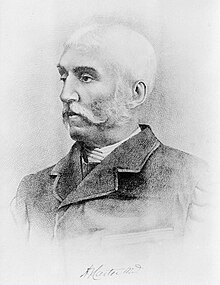Henry Vandyke Carter
Henry Vandyke Carter (born May 22, 1831 in Kingston upon Hull , † May 4, 1897 in Scarborough ) was a British anatomist, tropical medicine specialist and surgeon, best known for his illustrations for Gray's Anatomy .
Life
Carter was the son of the artist Henry Barlow Carter and apprenticed to a pharmacist and surgeon after attending grammar school in Hull. He also studied medicine at St. George's Hospital in London and anatomy at the Royal College of Surgeons (with Richard Owen and John Thomas Quekett ), which he became a member in 1852, with a Bachelor of Medicine degree from the University of London in 1854.
From 1852 he worked as an illustrator for Henry Gray and others and in 1856/57 created the illustrations for the standard work Gray's Anatomy , which first appeared in 1858. Both worked at St. George's Hospital Medical School, where Carter was an anatomy demonstrator until 1857. Around the same time he received his doctorate in medicine (MD) and he went to India in 1858 as a doctor in the Indian Medical Service and professor of anatomy and physiology at Grant Medical College in Bombay . He was also an assistant surgeon at Jamsetjee Jheejeebhoy Hospital. From 1863 to 1872 he was a surgeon (Civil Surgeon) in Satara . In 1876 he took over the management of the Goculdas Tejpal Hospital in Bombay. In 1877 he became director (principal) of Grant Medical College (initially provisional and then official) and chief physician of Jamsetjee Jheejeebhoy Hospital. After his retirement in 1888, he returned to England. He lived in Scarborough with his sister Lily and died there of tuberculosis in 1897. In retirement he was named Honorary Deputy Surgeon-General and Honorary Surgeon to the Queen .
He has made some contributions to research into tropical diseases. In 1861 he introduced the term mycetoma (with George Bidie ) for a fungal disease of the foot that had already been described by the English doctors John Gill (as Madura foot, 1842) and John Godfrey (as foot tuberculosis, 1846). The name mycetoma indicates its origin as a fungal disease, which Carter and Bidie recognized first. He also discovered the pathogen causing rat bite fever Spirillum minus (during an epidemic during the famine in 1877/78) and undertook important studies on leprosy , which he also studied during a visit to Europe in 1872 in Norway and other countries and in 1875 in Kathiawar .
Fonts
- The microscopic structure and mode of formation of urinary calculi, London, 1873
- On mycetoma or the fungus disease of India, London, 1874
- Report on leprosy and leper asylums of Norway, London, 1874
- On leprosy and elephantiasis, London, 1874
- Modern Indian leprosy, Bombay, 1876
- Reports on leprosy, second series, London, 1876
- Spirillum fever: synonyms famine or relapsing fever as seen in Western India, London, 1882
literature
- Obituary in British Medical Journal 1897, 1256–1257
- Obituary in Lancet 1897, p. 1381
- Ruth Richardson: The Making of Mr. Gray's Anatomy, Oxford University Press 2008
- JR Hiatt, N. Hiatt: The forgotten first career of Doctor Henry Van Dyke Carter, Journal of the American College of Surgeons 181, 1995, pp. 464-466, PMID 7582216
- Martin Kemp: Style and non-style in anatomical illustration: From Renaissance Humanism to Henry Gray, Journal of Anatomy, 216, 2010, 198–208, PMC 2815942 (free full text)
Web links
References and comments
- ↑ Luciano Polonelli, History of Medical Mycology, pdf ( Memento of the original from May 26, 2015 in the Internet Archive ) Info: The archive link was inserted automatically and has not yet been checked. Please check the original and archive link according to the instructions and then remove this notice.
| personal data | |
|---|---|
| SURNAME | Carter, Henry Vandyke |
| BRIEF DESCRIPTION | British anatomist, tropical medicine specialist, illustrator and surgeon |
| DATE OF BIRTH | May 22, 1831 |
| PLACE OF BIRTH | Kingston upon Hull |
| DATE OF DEATH | May 4, 1897 |
| Place of death | Scarborough |

